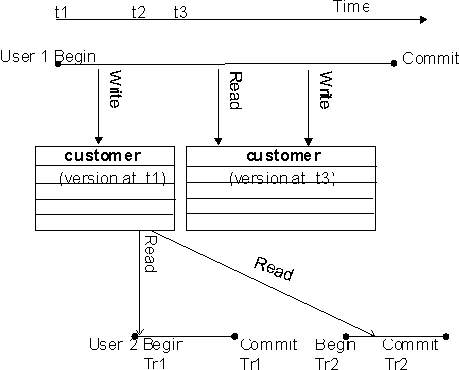Committed data results when a write transaction commits. Every transaction uses the latest committed version of the database as of the time the transaction begins. It uses that version until the transaction commits.
The time a transaction begins is called its Start Timestamp. The start timestamp can be any time before the transaction's first read. Any insertions and deletions the transaction makes are reflected in the snapshot. Thus, for the user executing a transaction, the image in the snapshot changes whenever that transaction writes data to the table, and then reads it again. For all other users, the image remains static until their transaction commits.
In other words, every transaction begins with a snapshot of the data in a reliable state. The snapshot of the data that you see when you issue a query does not change, even if another user is updating the table you are reading. For example, in Figure 10-4, when User 1's write transaction begins, it uses the customer table version that was committed most recently. User 2's transaction begins after User 1 has begun writing, but before User 1 commits. Therefore, User 2's first transaction (Tr1) does not see any of User 1's updates. User 2's second transaction begins after User 1 commits, so it sees all of User 1's changes.
Figure 10-4: Transactions use committed data

The data that a writer sees changes only according to the changes he or she makes; no other transaction can change what a writer sees until the writer's transaction commits. For example, in Figure 10-4, User 1 inserts some data, then does a query, and then deletes some data. Those query results reflect the insertions that User 1 has just made.
Other transactions that begin after User 1's transaction begins but before it commits see the version of the data from the time User 1's transaction begins. They can't see the latest changes, because those changes were not yet committed. As soon as User 1's transaction commits, new transactions see User 1's changes.